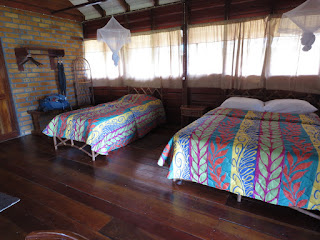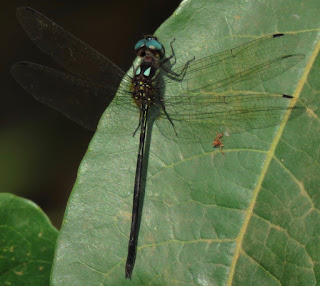I departed the WINGS group in Minas Gerais a day early in order to catch my flights to Georgetown for a private tour with my client-friend Joe Thompson. Joe is almost as much into butterflies and dragonflies as I am, and he had a very small list of target birds.
We first
took a short internal flight from Georgetown to Iwokrama, with a short stopover
in Fairview.
We flew over
miles and mile of untouched rainforest, arriving the middle of it all, and found a surprisingly
comfortable Iwokrama River Lodge.
Much of our
birding was along the main highway that runs southward through the middle of
the country. Since the southern towns are mostly provisioned through Brazil,
there was virtually no traffic along this road, making for great birding.
I was
surprised to see this metalmark Helicopis
cupido in the lodge as well; previously I had found it only in rather young
forest understory near permanent water.
Our second
accommodation was Atta Lodge, which I assumed was named after the genus of
leafcutter ants, but it turns out to be an indigenous word. Of course we did see some Atta sp. leafcutter ants, but this Daceton armigerum up in the canopy platform was much more impressive.
We first
spotted a Blackpoll Warbler at the canopy platform, but later we found one in
nearly every canopy mixed flock.
We never did
locate the highly desired Blue-and-yellow Tanager, but we had a truly fabulous
experience with the local and hard-to-see Red-and-black Grosbeak. I just barely
managed to get a photo in the dark understory.
As we
searched for these specialties, we encountered many cool critters. This is the
widespread South American Lancehead, Bothrops
atrox.
Though it
looks just like our northern firetails, this damselfly is a threadtail, Neoneura rubriventris.
The last few
days of the tour saw us in the seasonally dry interior, also with different
soils, resulting in a very different, much more open habitat. We met up with a
private vehicle driven by Fernando.
The
Vermilion Flycatchers here look very similar to the ones in Arizona, though the
dark areas are perhaps a bit darker.
A new bird
for both of us, and requiring a long jeep ride to a very specific location is
the spectacular Sun Parakeet.
During the
early part of that long drive we were entertained by this very confiding
Crab-eating Fox, Cerdocyon thous.
On another
walk in the savanna a local driver and guide spotted this gorgeous Tropical
Rattlesnake, Crotalus durissus.
These Mysoria barcastus firetip skippers may
be among the most colorful members of this typically drab family.

























No comments:
Post a Comment